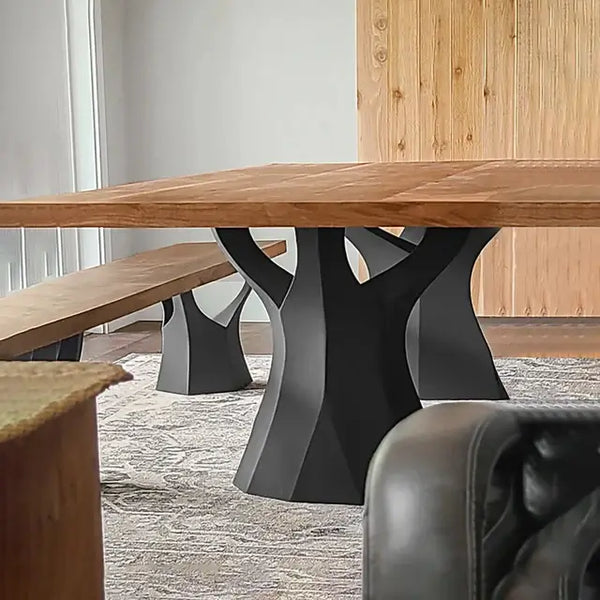Expert Tips for Setting Up Dining-room Table Legs for Optimum Security
When it comes to setting up eating space table legs, accomplishing maximum stability is extremely important for both performance and visual appeals. What specific strategies can improve stability even better?
Choose the Right Legs
When choosing the ideal legs for your dining room table, it is vital to consider both functionality and looks. The legs you pick will significantly affect the general style and security of the table. First, examine the table's planned usage; if you anticipate constant celebrations, tougher legs, such as those made from strong timber or steel, might be better, as they use increased durability and support.
Common dining tables generally vary from 28 to 30 inches in height, so ensure the legs straighten with this requirement for convenience. Tapered legs can include a contemporary touch, while turned legs may convey an extra classic visual.

Select Appropriate Equipment
Just how can the best equipment boost the stability and durability of your dining-room table? The selection of suitable equipment is crucial to making sure that the legs of your table are firmly attached and able to endure routine usage. High-quality screws, bolts, and brackets supply the essential strength to support the weight of the table, in addition to any type of added tons put upon it throughout dishes or celebrations.
When picking screws, go with those made from durable materials such as stainless steel or brass, which withstand rust and preserve stability gradually. The size of the screws is similarly crucial; they need to pass through deeply right into the table's framework without endangering honesty. For bolted links, think about using lock washers to prevent loosening as a result of vibration or movement.
Furthermore, using corner braces can include extra assistance, particularly for larger tables or those with heavier tops. These braces distribute weight evenly and aid preserve the table's shape. Making certain that the equipment you select is ideal for the certain materials of your table will even more enhance its general stability and long life, enabling you to appreciate your dining experience for years ahead.
Ensure Appropriate Alignment
Proper positioning of eating space table legs is vital for both visual allure and functional stability. To attain optimal positioning, start by gauging the distance from the table's corners to the leg accessory factors.
Make use of a degree throughout installment to validate that each leg is vertical to the table top. It is suggested to note the wanted leg placements on the bottom of the table with a pencil or masking tape prior to safeguarding them.
In addition, double-check the positioning after the first screws are tightened up, as adjustments may be necessary before totally safeguarding the equipment. By focusing on appropriate positioning, you not only enhance the table's total layout yet likewise guarantee that it remains stable and functional for many years to find.

Consider Weight Distribution
After making certain appropriate alignment of the dining-room table legs, it is necessary to take into consideration weight distribution to enhance security and functionality. dining room table legs. Correct weight distribution is essential in protecting against making sure and wobbling that the table can sustain its intended lots without risk of tipping or falling down
When positioning the legs, guarantee they are placed at equivalent ranges from the center of the table to equally distribute the weight across the framework. Consider the weight of the table top and any products that will regularly rest on it, such as attractive pieces or tabletop home appliances. Tables with larger surfaces must preferably have legs positioned closer to the edges, as this takes full advantage of the base of support and minimizes the danger of instability.
In addition, if the table is intended for use in a high-traffic location, take into consideration utilizing larger products for the legs or adding supporting aspects, such as cross-bracing or a reduced shelf - dining room table read this post here legs. These adjustments can assist keep equilibrium and prevent moving throughout usage. Inevitably, a well-considered weight distribution technique will dramatically enhance the table's overall performance, ensuring it stays a eye-catching and functional centerpiece for your dining space
Test Stability Before Use
Checking the stability of the dining area table prior to use is a vital action that ought to not be neglected. If the table shows instability, recognize the legs or joints that might need modification.
Next, check that all screws and bolts are tightened properly. Loosened connections can lead to instability and possible damage over view publisher site time. If essential, make use of wood adhesive on joints to improve stability, making certain to enable sufficient drying out time.

Verdict
To conclude, the setup of eating room table legs needs careful factor to consider of materials, weight, hardware, and positioning distribution to accomplish optimum security. By picking premium bolts and tough legs, making sure precise placement, and dispersing weight evenly, the structural honesty of the table can be dramatically enhanced. Conducting a stability examination before regular usage even more guarantees that the table will certainly endure day-to-day pressures, consequently providing a risk-free and reputable eating experience.
When it comes to mounting eating space table legs, accomplishing optimum stability is extremely important for both capability and looks. The legs you pick will dramatically impact the general layout and stability of the table (dining room table legs). Standard eating tables typically range from 28 to 30 inches in elevation, so make sure the legs straighten with this requirement for convenience.Correct alignment of dining area table legs is essential for both aesthetic allure and practical stability.In conclusion, the setup of eating space table legs calls for mindful consideration of products, weight, positioning, and equipment distribution to attain maximum security